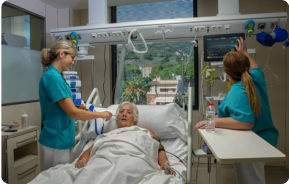

- ReumatologíaCentro Médico Teknon
 ReumatologíaHospital Universitari Sagrat Cor - Centro Médico Teknon
ReumatologíaHospital Universitari Sagrat Cor - Centro Médico Teknon
Los factores de crecimiento plaquetario (FCP), también conocidos como plasma rico en plaquetas (PRP), son una forma de terapia regenerativa que utiliza la propia sangre del paciente para obtener un concentrado de plaquetas en plasma con una concentración elevada de factores de crecimiento.
Las plaquetas son componentes de la sangre responsables de la coagulación y la cicatrización de heridas. Además, contienen una variedad de proteínas bioactivas, como los factores de crecimiento, que desempeñan un papel crucial en el proceso de reparación y regeneración de tejidos.
El PRP se obtiene mediante la extracción de una muestra de sangre del paciente y su posterior procesamiento. Durante este proceso, la sangre se centrifuga para separar los componentes y obtener un concentrado de plaquetas en plasma, que contiene una mayor concentración de factores de crecimiento en comparación con la sangre periférica.
Los factores de crecimiento presentes en el PRP incluyen el factor de crecimiento derivado de las plaquetas (PDGF), el factor de crecimiento transformador beta (TGF-β), el factor de crecimiento vascular endotelial (VEGF), el factor de crecimiento epidérmico (EGF) y otros. Estas proteínas bioactivas desempeñan funciones clave en la reparación y regeneración de tejidos, estimulando la proliferación celular, la formación de nuevos vasos sanguíneos y la síntesis de matriz extracelular.
El PRP se ha utilizado en diversas áreas médicas, incluyendo la dermatología y la odontología; y en el ámbito del tratamiento de lesiones musculoesqueléticas, como la artrosis, las lesiones de ligamentos y tendones, y las fracturas óseas.
Es importante destacar que si bien el PRP ha mostrado resultados prometedores en algunos casos, su efectividad y beneficios específicos pueden variar según la condición médica y las características individuales de cada paciente.
Algunas de las aplicaciones más comunes del PRP en la artrosis de rodilla incluyen:
Infiltración intraarticular de PRP:
El PRP se inyecta directamente en la articulación de la rodilla afectada. Los factores de crecimiento presentes en el PRP actúan de varias maneras:
- Estimulan la proliferación y diferenciación de células madre y células condrocíticas, que son las responsables de la formación y mantenimiento del cartílago articular.
- Promueven la síntesis de matriz extracelular, lo que contribuye a la reparación y regeneración del cartílago dañado.
- Reducen la inflamación en la articulación de la rodilla, lo que puede aliviar los síntomas dolorosos asociados con la artrosis.
- Mejoran la vascularización local, facilitando el suministro de nutrientes y factores de crecimiento necesarios para la reparación del cartílago.
Combinación con procedimientos quirúrgicos:
El PRP se ha utilizado como adyuvante en procedimientos quirúrgicos para el tratamiento de la artrosis de rodilla, como la cirugía de microfractura o el trasplante de condrocitos autólogos. Se aplica en el sitio de la lesión para potenciar la regeneración del tejido y mejorar los resultados a largo plazo.
Es muy importante destacar que, si bien existen algunos estudios que respaldan el uso del PRP en la artrosis de rodilla, los resultados son variables y las revisiónes sistemáticas y metaanálisis realizados concluyen que aún se requiere más investigación para determinar su eficacia, y establecer las preparaciones y las pautas de tratamiento más adecuadas. Además, se debe saber que la respuesta a este tratamiento puede tener grandes variaciones según las características individuales de cada paciente.
































